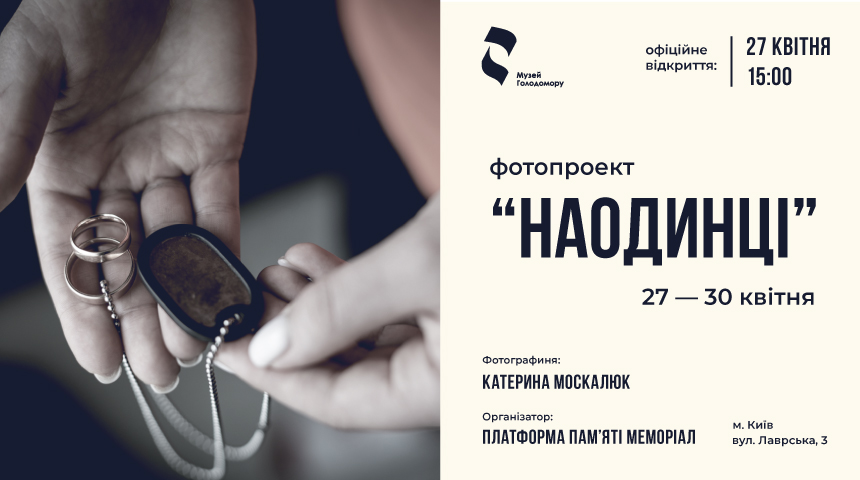“Alone”. The photo exhibition dedicated to the wives of fallen Heroes on April 27-30
“Alone”. A photo exhibition dedicated to the wives of fallen Heroes is going to be presented in Kyiv
From April 27 to 30, the Holodomor Museum will host a photo exhibition, “Alone”. This project aims to support thousands of Ukrainian women and men who lose their loved ones in the war.
Official opening: April 27 at 3:00 p.m. with the participation of the organizers. Entrance is free at 3 Lavrska Street.
The Memorial platform initiated and implemented the photo project. The project team collects data on civilians and military killed in the war and does everything to preserve the memory of every person whose life was taken by the Russian military.
“The National Museum of the Holodomor-genocide collects witnesses’ testimonies of the genocides of the Ukrainian people. Personal stories of Ukrainian heroes: those who survived, who fought, who saved and saved themselves. All of them are our story of heroism, which continues today also through the mission of the Memorial platform,” says Maryna Bohush, deputy head of the exposition and exhibition department of the National Museum of the Holodomor-genocide.
The author of the photo project, Kateryna Moskaliuk, is a journalist and documentary photographer. Before the full-scale Russian invasion of Ukraine started, she had worked on sensitive topics. Now she documents the consequences of the war.
“My photo project is about stories about love and loss, about tenderness and pain. Women talked about their favourite places where they liked spending time with their husbands, showed things that remind them of their loved ones and how they try to live on. My photo project is about women whose husbands did not choose their lives, but our lives,” Katia says.
Kateryna’s works have been published in GEO, Bloomberg Businessweek, Die Zeit, Bird in Flight, The Ukrainians, Ukrainer, Evacuation.City, Zaborona, Kunsht, Forbes Ukraine and others, as well as presented at international exhibitions in Ukraine, the USA, Great Britain, Denmark , Japan, Hong Kong, Cyprus, Armenia and others.
“Alone” tells about the fate of five women who lost their husbands in the war:
- □ Ksenia Biriukova from Kharkiv lost her husband Mykhailo Mitusov in August 2022.
- □ Anhelina Popsuy from Dnipro lost her husband Oleksandr Popsuy in October 2022.
- □ Indira Baranetska from Odesa lost her husband Viacheslav Baranetsky in September 2022.
- □ Maria Onyshchenko from Kyiv lost her husband Andrii Onyshchenko in July 2022.
- □ Yeva Fialka from Lviv lost her husband Dmytro Fialka in September 2022.
“I got a tattoo with the dates of my husband’s birth and death to somehow fill this void,” says Yeva from Lviv. “His ring is always with me. When our daughter grows up, I will pass it on to her,” says Ksenia from Kharkiv. “Traces of his blood remained on the military medallion,” says Anhelina from Dnipro. “I made a pendant with his name, that’s how I feel his presence,” says Maria from Kyiv. “This cup remembers the warmth of his hands and the touch of his lips,” recalls Indira from Odessa.
“The war is taking away their loved ones from thousands of Ukrainians. On the shoulders of widows and widowers fall the responsibilities that they previously shared with their partners. Our great social task is to learn to hear and support people who have lost loved ones,” says the editor-in-chief of the Memorial, Anastasia Abramets.
- □ tell about the civilian victim;
- □ tell about the dead soldier.
“Ukrainian resistance is a feature of our character that was carved out over years and decades under the pressure of external circumstances. This challenge has always been the same: when the Ukrainian lands were occupied by the Bolsheviks in the 1920s, they set themselves the goal of destroying Ukrainianness – our culture, our everyday life, way of life, thinking – ourselves. We were to become part of their system. The very existence of Ukrainians was at stake, so of course we resisted. In the 1930s, thousands of women and men, together and alone, with weapons or what could become weapons in their hands, resisted the enemy in every possible way. Unfortunately, the Holodomor of 1932-33, a genocide that made physical survival impossible for millions, was able to suppress Ukrainian resistance. But not its idea. Today it is relevant and important again. The same enemy is Russia. And the Ukrainian resistance continues,” Maryna Bohush, deputy head of the exposition and exhibition department of the National Museum of the Holodomor-genocide, thinks.
